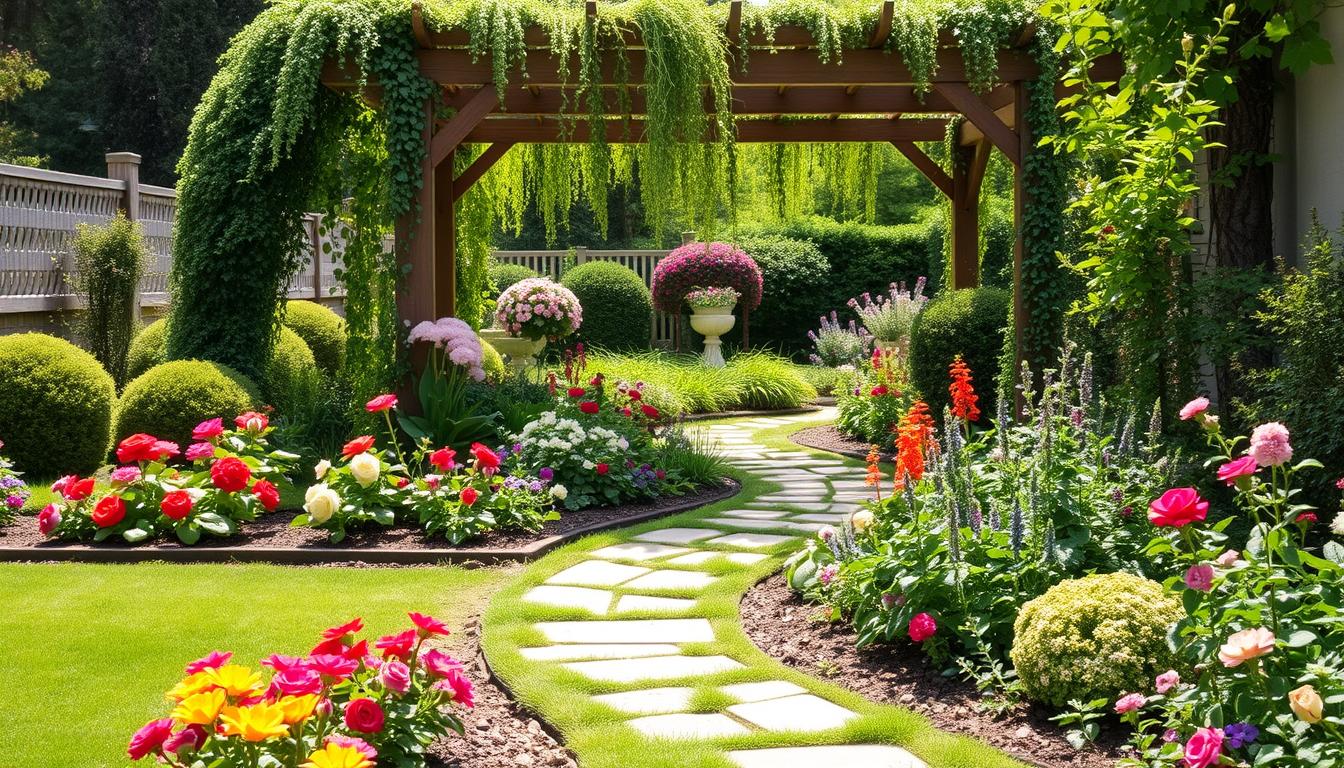Creating a multi-functional outdoor area is a top priority for many homeowners. A well-designed space can serve as a place for relaxation, dining, and even growing fresh produce. With 72% of homeowners valuing versatility, it’s clear that modern outdoor areas need to balance beauty and practicality.
Family-friendly designs are essential for households with kids or pets. Dedicated growing zones can protect your plants from accidental damage while still allowing everyone to enjoy the area. Whether you’re starting small or planning a larger project, thoughtful layouts make all the difference.
From Ohio to Colorado, real-life examples show how clear bed definitions and creative layouts can transform any space. Tools like the Almanac Garden Planner’s free trial can help you visualize your dream setup. Let’s explore ideas that inspire both functionality and beauty.
Key Takeaways
- Modern outdoor spaces combine recreation, dining, and gardening.
- Family-friendly designs protect plants from foot traffic and pets.
- Clear bed definitions enhance both aesthetics and functionality.
- Real-life examples from different states offer practical inspiration.
- Tools like the Almanac Garden Planner simplify layout design.
1. Planning Your Backyard Garden Layout
Start by assessing your space to create a functional and beautiful design. Understanding your location, sun patterns, and soil type is crucial. For example, a family in Denver planned their raised beds with future pergola goals, while a gardener in Lebanon, MO tackled heavy clay soil with a phased approach.
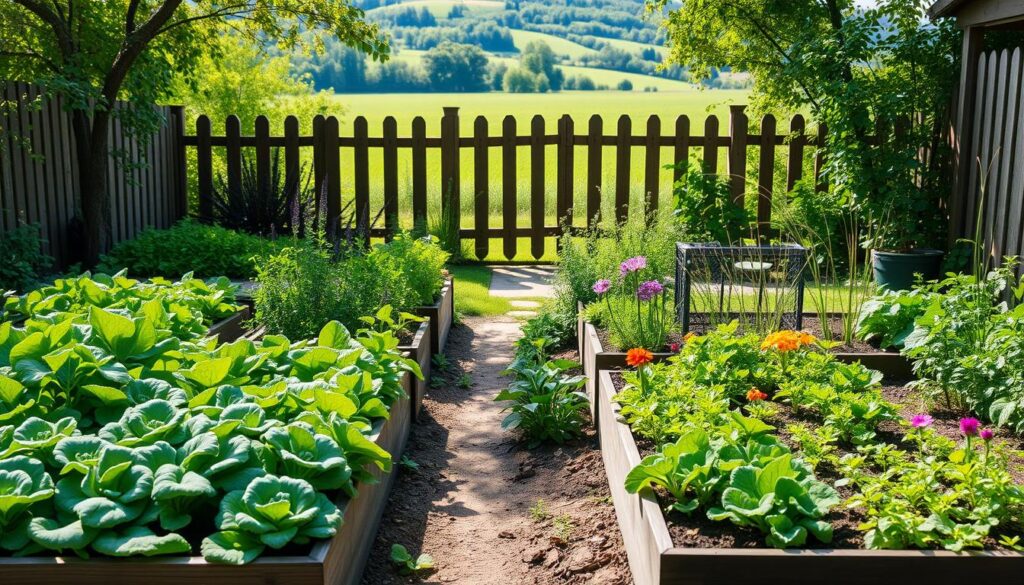
Assess Your Space and Needs
Measure sun exposure using tools like the Garden Planner’s sunlight tracker. This helps determine the best spots for your vegetable garden. Consider your family’s needs—dedicated play areas for children can be protected with low edging materials like wicker or corrugated metal.
Choose Between Traditional Rows and Raised Beds
Compare layouts like Colorado’s 29’11” square raised bed system with Ohio’s 60′ row setup. Raised beds are ideal for poor soil, while traditional rows work well for larger spaces. “Dedicated edible areas,” as Catherine Boeckmann suggests, ensure clarity and functionality.
Incorporate Multi-Use Areas
Allocate zones for dining, relaxation, and gardening. For instance, the Denver family’s plan includes a future pergola for shaded seating. Strategic placement of beds and pathways ensures a seamless flow between activities.
| Layout Type | Best For | Example |
|---|---|---|
| Raised Beds | Poor soil, small spaces | Denver family’s 29’11” design |
| Traditional Rows | Large areas, easy access | Ohio’s 60′ row system |
“A well-planned garden layout is the key to balancing beauty and practicality.”
2. Designing a Functional and Beautiful Backyard Garden
Blending practicality with aesthetics is the secret to a stunning outdoor setup. By dividing your space into purposeful zones and choosing the right materials, you can create an area that’s both inviting and efficient. Let’s explore how to achieve this balance.
Create Garden Rooms for Different Activities
Dividing your outdoor area into distinct “rooms” can enhance its functionality. For example, Janet Loughrey’s screened porch overlooks a wildlife pond, creating a serene retreat. Similarly, Alli Guileria’s canopy-protected seating area offers ample space for entertaining guests.
Consider connecting cooking and dining zones to your indoor kitchen for seamless entertaining. This approach not only maximizes convenience but also extends your living space outdoors.
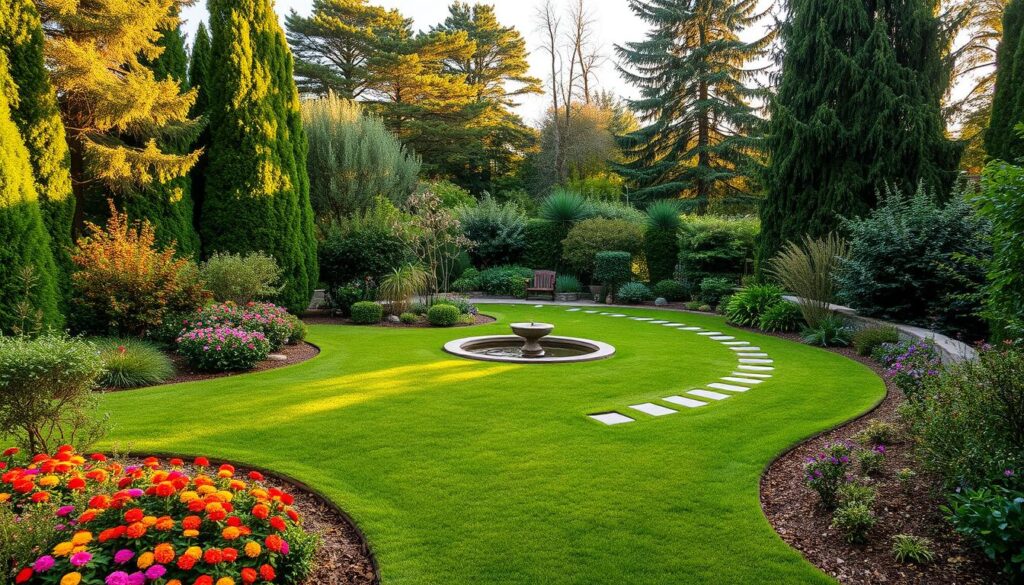
Use Pathways and Transition Areas
Pathways are essential for guiding movement and defining spaces. Lori Scott’s waterfall strategy, for instance, masks urban noise while adding a calming element. Choose permeable pavers like Marina Wynton’s eco-friendly gravel design for a sustainable touch.
For narrow spaces, Debbie Brooks’ solution with bar seating and an outdoor kitchen is a smart choice. It ensures every inch is utilized effectively.
Select Hardscape Materials That Complement Your Home
The materials you choose can make or break your design. Opt for options that match your house’s style and enhance the overall look. Tall planters can balance open sightlines while adding a touch of greenery.
For a cohesive look, consider incorporating boho yard decor ideas that blend seamlessly with your hardscape choices. This creates a harmonious and visually appealing space.
“A well-designed outdoor area is an extension of your home, reflecting your lifestyle and personality.”
3. Choosing the Right Plants for Your Backyard Garden
Selecting the right plants can transform your outdoor space into a thriving oasis. The key is to consider your location, sunlight, and soil type. Whether you’re aiming for a pollinator-friendly area or a wildlife pond ecosystem, thoughtful choices make all the difference.
Consider Light and Soil Conditions
Understanding your space’s light and soil conditions is essential. Test your soil’s pH levels to ensure it has the right nutrients for your chosen plants. For areas with heavy clay, opt for tolerant varieties like those in Missouri’s Plan B garden.
Sunlight is another critical factor. Use tools like the Garden Planner’s sunlight tracker to determine the best spots for your plants. Areas with partial shade can still thrive with the right selections.

Incorporate Native Plants for Sustainability
Native plants are a sustainable choice, requiring less water and maintenance. They also support local wildlife. Follow the “15% native minimum” rule, as seen in Delaware’s pond garden case study, to create a balanced ecosystem.
For example, Proven Winners’ pollinator-attracting island bed strategy combines native flowers with shrubs to attract bees and butterflies. This approach enhances both beauty and biodiversity.
Mix Vegetables, Flowers, and Shrubs for Variety
Layering plants vertically adds depth and interest to your space. Clare Dohna’s mosaic-art inspired arrangements show how combining vegetables, flowers, and shrubs can create a stunning visual effect.
Pair nitrogen-fixing legumes with crops to improve soil fertility naturally. This method, recommended by Source 3, ensures your plants receive the nutrients they need to thrive.
“The right plant in the right place can turn any space into a masterpiece.”
4. Maximizing Small Backyard Spaces
Small outdoor spaces can be just as impactful as larger ones with the right design. With a few creative strategies, you can transform even the tiniest area into a lush and functional retreat. Let’s explore how to make the most of your limited space.
Go Vertical with Trellises and Arbors
Vertical gardening is a game-changer for small areas. Install trellises or arbors to grow climbing plants like Proven Winners’ trumpet vine. This not only saves space but also adds privacy and beauty to urban yards.
Laura Crockett’s tile mosaic garden demonstrates how vertical layering can create depth and interest. By stacking plants vertically, you can maximize every inch of your space without feeling cramped.
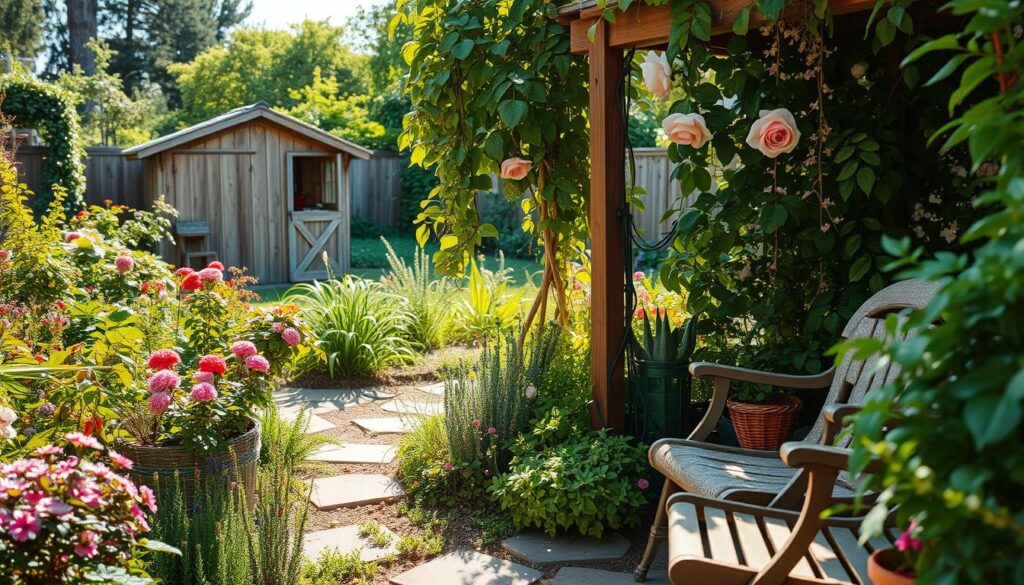
Use Containers and Hanging Baskets
Containers and hanging baskets are perfect for small spaces. They allow you to grow plants without taking up valuable ground area. Megan Wade’s green-roof shed design is a great example of stacked functionality.
Movable container gardens offer flexibility, letting you rearrange your setup as needed. This approach is ideal for those who want to experiment with different layouts throughout the year.
Opt for Dwarf Varieties of Plants
Choosing compact plants is key to maximizing small spaces. Dwarf fruit trees, like those used in Lebanon, MO’s Phase A starter plants, serve as living sculptures in narrow side yards.
These smaller varieties require less space and much time to maintain, making them perfect for busy homeowners. Plus, they add charm and character to your outdoor area.
“With creativity and smart planning, even the smallest space can become a thriving oasis.”
5. Building and Maintaining Raised Beds
Raised beds offer a versatile solution for growing plants in various conditions. Whether you’re dealing with poor soil or limited space, these structures provide better control over your growing environment. They’re also easier to maintain and can extend your growing season.
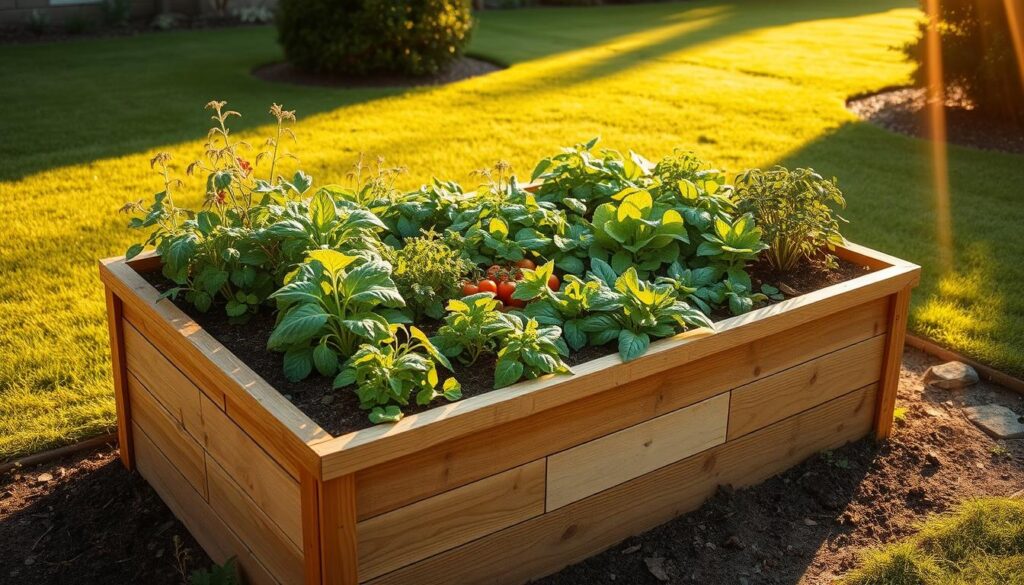
Benefits of Raised Bed Gardening
One of the biggest advantages of raised beds is improved soil quality. You can customize the mix to ensure your plants get the right nutrients. They also help with drainage, especially in areas with heavy clay soil.
Raised beds are easier to access, reducing strain on your back and knees. They also keep weeds at bay and protect plants from pests. For families, they create clear boundaries to prevent accidental damage from foot traffic.
Materials and Construction Tips
When building raised beds, choose durable materials like cedar or composite wood. Cedar is naturally resistant to rot, while composite materials last for years with minimal maintenance. For example, a Denver family used cedar for their 29’11” square design.
Calculate the soil volume needed based on your bed size. A Missouri gardener’s 25’x15’11” plan required careful measurements to ensure proper depth. Use tools like the Garden Planner to simplify this process.
Soil Preparation and Maintenance
Start by layering fresh compost over cardboard to smother weeds. This “lasagna gardening” technique is especially effective for improving heavy clay soil. Add aged manure in the fall to enrich the soil for the next growing season.
Schedule seasonal amendments to keep your beds productive. Follow Ohio’s maintenance calendar for timing tips. Regularly check for pests and diseases to ensure your plants stay healthy.
“Raised beds are a game-changer for gardeners, offering control, convenience, and better yields.”
6. Enhancing Your Backyard Garden with Lighting and Accessories
Transform your outdoor area into a magical retreat with thoughtful lighting and accessories. These elements not only improve functionality but also create a welcoming atmosphere. Whether you’re hosting guests or enjoying a quiet evening, the right touches can make all the difference.

Add Pathway and Patio Lighting for Safety
Proper lighting ensures safety while adding a warm glow to your space. Use Proven Winners’ uplighting techniques to highlight trees and structures. This approach not only illuminates pathways but also enhances the overall quality of your outdoor experience.
Follow Pennsylvania’s safety protocols when designing your lighting plan. Solar-powered lights are an eco-friendly option, while LED fixtures provide long-lasting brightness. Strategic placement ensures every corner of your space is well-lit and inviting.
Incorporate Water Features for Ambiance
Water features like rain chains and birdbaths add a soothing touch to your outdoor area. Janet Loughrey’s wildlife-focused designs show how these elements can attract birds and create a serene atmosphere. The sound of flowing water masks urban noise, making your space feel like a peaceful retreat.
Choose features that fit your location and style. A small fountain or pond can become a focal point, while rain chains add charm to your home’s exterior. These additions bring life and movement to your outdoor area.
Use Decorative Pots and Garden Art
Decorative pots and art pieces add personality to your outdoor space. Laura Crockett’s mosaic installations serve as stunning focal points. Clare Dohna’s custom clay tile mosaics also demonstrate how art can elevate the beauty of your garden.
Select weather-resistant furnishings that last for years. Colorado’s 3-5 year pergola plan highlights the importance of durability. Combine functional and decorative elements, like fire pit seating areas, to create a cohesive and inviting space.
“Lighting and accessories are the finishing touches that turn a space into a sanctuary.”
7. Seasonal Care and Maintenance Tips
Keeping your outdoor space thriving year-round requires a solid seasonal care plan. Each season brings unique challenges and opportunities for your plants. By following a structured approach, you can ensure your area remains healthy and vibrant.
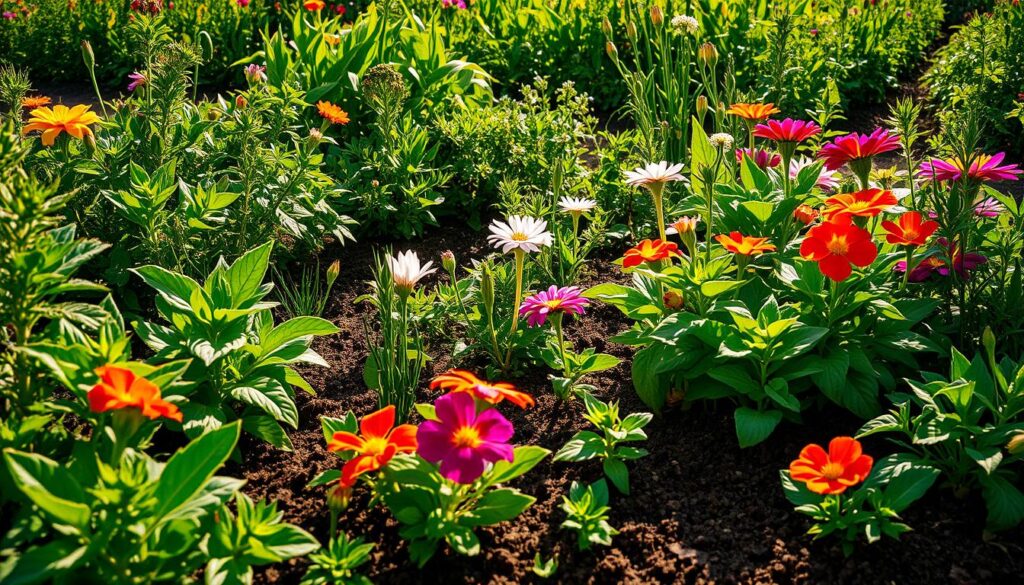
Preparing Your Garden for Spring Planting
Spring is the perfect time to prepare your soil for new growth. Start by testing your soil’s pH levels and nutrient content. Janet Loughrey’s guide recommends using a simple kit to determine what amendments are needed.
Add organic matter like compost to enrich the soil. As Source 3 notes, “It’s never too late to add organic matter.” This step ensures your plants have the nutrients they need to thrive. Schedule tasks using Ohio’s month-by-month planner for optimal results.
Summer Watering and Weeding Strategies
Summer demands consistent watering and weeding to keep your plants healthy. Implement a drip irrigation system, like Denver’s raised bed design, to ensure efficient water use. This method saves time and reduces water waste.
Develop a weed management routine using biodegradable mulch. This prevents weeds from competing with your plants for resources. Regular maintenance keeps your area looking neat and productive.
Fall Cleanup and Soil Enrichment
Fall is the ideal time to prepare for the next growing season. Clean up fallen leaves and debris to prevent pests and diseases. Apply compost layers using Missouri’s clay soil amendment strategy to improve soil structure.
Integrate legume cover crops, as recommended by Source 3, to naturally fix nitrogen in the soil. This step ensures your soil remains fertile and ready for spring planting.
| Season | Key Tasks | Example |
|---|---|---|
| Spring | Soil testing, compost application | Ohio’s month-by-month planner |
| Summer | Drip irrigation, weeding | Denver’s raised bed system |
| Fall | Cleanup, soil enrichment | Missouri’s clay soil strategy |
“A well-maintained garden adapts to the seasons, ensuring beauty and productivity year-round.”
Conclusion
Designing a thriving outdoor space starts with thoughtful planning and creativity. Whether you choose Ohio’s traditional rows, Colorado’s raised beds, or Missouri’s phased approach, each layout offers unique benefits. Janet Loughrey’s “garden room” philosophy highlights the importance of multi-use areas, blending functionality with beauty.
For beginners, the Almanac Planner’s free trial, endorsed by Catherine Boeckmann, is a valuable tool to visualize your dream setup. Starting small, like the manageable first-year approach in Lebanon, MO, ensures success without overwhelming effort.
Remember, even if your garden doesn’t thrive the first time, it improves the soil for future years. With the right plants and a bit of patience, your outdoor space can become a lush retreat for relaxation and growth.

